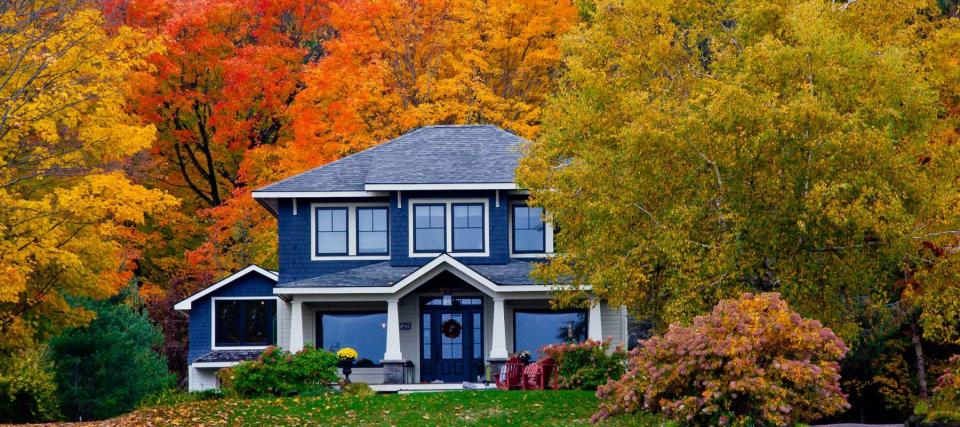Homeowners say 'no thanks' to refinance savings — despite low mortgage rates

Even though mortgage rates have been stuck at historically low levels as a result of America’s ongoing COVID-19 crisis, demand for mortgage refinances continues to fall.
The number of applications for refi loans has fallen for the third week in a row, according to a new survey by the country’s largest mortgage trade association.
This isn’t the first time homeowners have turned their backs on what could be solid savings. A recent study found that a mind-boggling 78% of homeowners chose not to refinance their mortgages between April 2020 and April 2021. Of those who did, almost half saved $300 or more a month.
Today’s mortgage rates are even lower than what many of those borrowers would have been offered. But with COVID no longer the economy-crusher it once was, rates could be on the rise before you know it.
Refinance activity slips again
While overall mortgage activity ticked up by 0.3% for the week ending September 10, refinance activity dipped by 3% compared to the week before, the Mortgage Bankers Association reported on Wednesday. Refi activity was also 3% lower than it was at this time last year.
That’s despite the nation’s most popular mortgage product, the 30-year fixed, remaining affordable.
"While the 30-year fixed rate was unchanged at just over 3 percent, it was not enough to drive more refinance activity, said Joel Kan, MBA's associate vice president of economic and industry forecasting. “Refinance applications slipped to their slowest pace since early July, and the refinance share of applications fell to 65 percent, which was also the lowest since July."
That’s interesting, because mortgage rates in July were almost identical to what they are now. The average rate on a 30-year fixed mortgage on July 9, 2.9%, was actually higher than it was on September 16, when it was calculated by mortgage giant Freddie Mac to be 2.86%%.
Could homeowners be putting off a refinance because they think the current wave of COVID infections will once again squash mortgage rates to record lows?
Let’s hope not. They’re bound to be disappointed.
Record-low mortgage rates aren’t on tap this time
Even though COVID infections are at their highest point since January, when mortgage rates hit rock-bottom, a similar boon for homeowners isn’t likely to materialize.
The difference? The economy. Not only is it in better shape, with more than two million new jobs created in the last three months, but it’s actually open. There are no business-shuttering COVID restrictions in place in the U.S., and there don’t appear to be any planned.
If businesses are allowed to operate normally, the downward pressure that the 2020 economy put on mortgage rates is pretty much non-existent.
The COVID situation is catastrophic, and the uncertainty it has caused is holding rates in place, but it’s not an economic catastrophe. That’s something Corey Burr, senior vice president at TTR Sotheby's International Realty in Washington, D.C., says will be necessary for mortgage rates to be ground down even further.
“In order for mortgage rates to fall to the levels seen in early 2021, there will need to be a lot of talk about the ‘R’ word,” Burr says. “Recession.”
Secure a low rate for your mortgage refinance
If you've put off refinancing your mortgage, you could be leaving a lot of money on the table. Even a monthly savings of “only” $100 on your mortgage payment would add up to $6,000 over five years. That’s money you can use to pay off nagging, high-interest debt, fund your kids’ education or invest in the stock market.
Just keep in mind that a lender may not automatically offer you the lowest interest rate available. That usually requires a little bit of effort on your part.
A good first step is to take a quick, free look at your credit score. The lowest mortgage rates tend to be given to borrowers with the highest scores. Finding out where yours ranks will tell you if your score would benefit from a little rehab before reaching out to a lender and getting offered a higher rate.
When you decide to refinance your home, you’ll want to check mortgage rates from at least five lenders. It’s a quick and easy way to find the rate that best fits your budget.
If a refi isn't possible or something you want to do, there are other ways to cut the cost of homeownership. When the time comes to buy or renew homeowners insurance, for example, make sure you get quotes from multiple insurers. A few minutes of comparison shopping could save you hundreds of dollars.
This article provides information only and should not be construed as advice. It is provided without warranty of any kind.

 money
money 